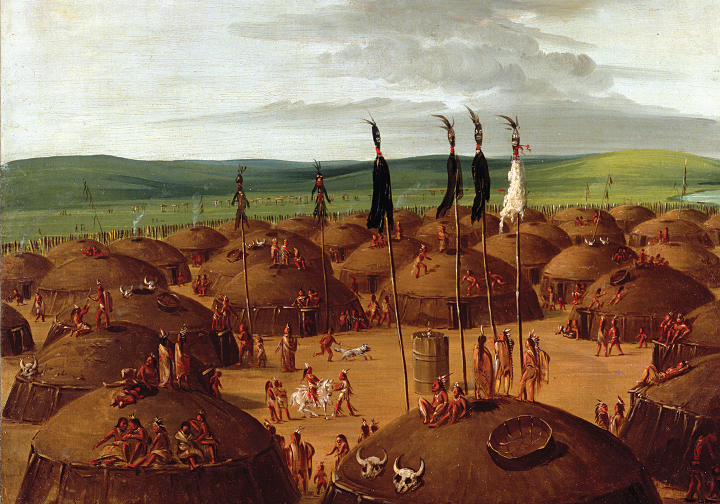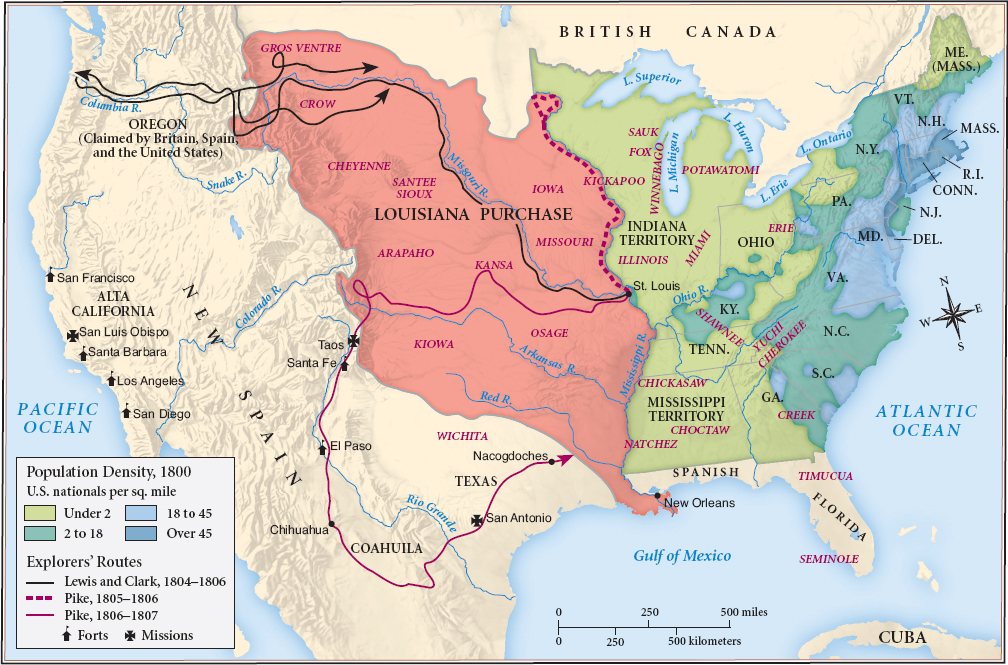America’s History: Printed Page 231
America: A Concise History: Printed Page 210
America’s History: Value Edition: Printed Page 205
Jefferson and the West
Jefferson had long championed settlement of the West. He celebrated the yeoman farmer in Notes on the State of Virginia (1785); wrote one of the Confederation’s western land ordinances; and supported Pinckney’s Treaty (1795), the agreement between the United States and Spain that reopened the Mississippi River to American trade and allowed settlers to export crops via the Spanish-held port of New Orleans.
As president, Jefferson pursued policies that made it easier for farm families to acquire land. In 1796, a Federalist-dominated Congress had set the price of land in the national domain at $2 per acre; by the 1830s, Jefferson-inspired Republican Congresses had enacted more than three hundred laws that cut the cost to $1.25, eased credit terms, and allowed illegal squatters to buy their farms. Eventually, in the Homestead Act of 1862, Congress gave farmsteads to settlers for free.
The Louisiana Purchase International events challenged Jefferson’s vision of westward expansion. In 1799, Napoleon Bonaparte seized power in France and sought to reestablish France’s American empire. In 1801, he coerced Spain into signing a secret treaty that returned Louisiana to France and restricted American access to New Orleans, violating Pinckney’s Treaty. Napoleon also launched an invasion to restore French rule in Saint-Domingue. It was once the richest sugar colony in the Americas, but its civil war had ruined the economy and cost France a fortune. Napoleon wanted to crush the rebellion, restore its planter class, and “destroy the new Algiers that has been growing up in the middle of America.”
Napoleon’s actions in Haiti and Louisiana prompted Jefferson to question his pro-French foreign policy. “The day that France takes possession of New Orleans, we must marry ourselves to the British fleet and nation,” the president warned, dispatching James Monroe to Britain to negotiate an alliance. To keep the Mississippi River open to western farmers, Jefferson told Robert Livingston, the American minister in Paris, to negotiate the purchase of New Orleans.
Jefferson’s diplomacy yielded a magnificent prize: the entire territory of Louisiana. By 1802, the French invasion of Saint-Domingue was faltering in the face of disease and determined black resistance, a new war threatened in Europe, and Napoleon feared an American invasion of Louisiana. Acting with characteristic decisiveness, the French ruler offered to sell the entire territory of Louisiana for $15 million (about $500 million today). “We have lived long,” Livingston remarked to Monroe as they concluded the Louisiana Purchase in 1803, “but this is the noblest work of our lives.”
The Louisiana Purchase forced Jefferson to reconsider his strict interpretation of the Constitution. He had long believed that the national government possessed only the powers expressly delegated to it in the Constitution, but there was no provision for adding new territory. So Jefferson pragmatically accepted a loose interpretation of the Constitution and used its treaty-making powers to complete the deal with France. The new western lands, Jefferson wrote, would be “a means of tempting all our Indians on the East side of the Mississippi to remove to the West.”
Secessionist Schemes The acquisition of Louisiana brought new political problems. Some New England Federalists, fearing that western expansion would hurt their region and party, talked openly of leaving the Union and forming a confederacy of northeastern states. The secessionists won the support of Aaron Burr, the ambitious vice president. After Alexander Hamilton accused Burr of planning to destroy the Union, the two fought an illegal pistol duel that led to Hamilton’s death.
This tragedy propelled Burr into another secessionist scheme, this time in the Southwest. When his term as vice president ended in 1805, Burr moved west to avoid prosecution. There, he conspired with General James Wilkinson, the military governor of the Louisiana Territory, either to seize territory in New Spain or to establish Louisiana as a separate nation. But Wilkinson, himself a Spanish spy and incipient traitor, betrayed Burr and arrested him. In a highly politicized trial presided over by Chief Justice John Marshall, the jury acquitted Burr of treason.
The Louisiana Purchase had increased party conflict and generated secessionist schemes in both New England and the Southwest. Such sectional differences would continue, challenging Madison’s argument in “Federalist No. 10” that a large and diverse republic was more stable than a small one.
Lewis and Clark Meet the Mandans and Sioux A scientist as well as a statesman, Jefferson wanted information about Louisiana: its physical features, plant and animal life, and native peoples. He was also worried about intruders: the British-run Hudson’s Bay Company and Northwest Company were actively trading for furs on the upper Missouri River. So in 1804, Jefferson sent his personal secretary, Meriwether Lewis, to explore the region with William Clark, an army officer. From St. Louis, Lewis, Clark, and their party of American soldiers and frontiersmen traveled up the Missouri for 1,000 miles to the fortified, earth-lodge towns of the Mandan and Hidatsa peoples (near present-day Bismarck, North Dakota), where they spent the winter.

The Mandans lived primarily by horticulture, growing corn, beans, and squash. They had acquired horses by supplying food to nomadic Plains Indians and secured guns, iron goods, and textiles by selling buffalo hides and dried meat to European traders. However, the Mandans (and neighboring Arikaras) had been hit hard by the smallpox epidemics that swept across the Great Plains in 1779–1781 and 1801–1802. Now they were threatened by Sioux peoples: Tetons, Yanktonais, and Oglalas. Originally, the Sioux had lived in the prairie and lake region of northern Minnesota. As their numbers rose and fish and game grew scarce, the Sioux moved westward, acquired horses, and hunted buffalo, living as nomads in portable skin tepees. The Sioux became ferocious fighters who tried to reduce the Mandans and other farming tribes to subject peoples. According to Lewis and Clark, they were the “pirates of the Missouri.” Soon the Sioux would dominate the buffalo trade throughout the upper Missouri region.
In the spring of 1805, Lewis and Clark began an epic 1,300-mile trek into unknown country. Their party now included Toussaint Charbonneau, a French Canadian fur trader, and his Shoshone wife, Sacagawea, who served as a guide and translator. After following the Missouri River to its source on the Idaho-Montana border, they crossed the Rocky Mountains, and — venturing far beyond the Louisiana Purchase — traveled down the Columbia River to the Pacific Ocean. Nearly everywhere, Indian peoples asked for guns so they could defend themselves from other armed tribes. In 1806, Lewis and Clark capped off their pathbreaking expedition by providing Jefferson with the first maps of the immense wilderness and a detailed account of its natural resources and inhabitants (Map 7.4). Their report prompted some Americans to envision a nation that would span the continent.

EXPLAIN CONSEQUENCES
Question
How was Jefferson’s agrarian vision reflected in his policies affecting western lands?